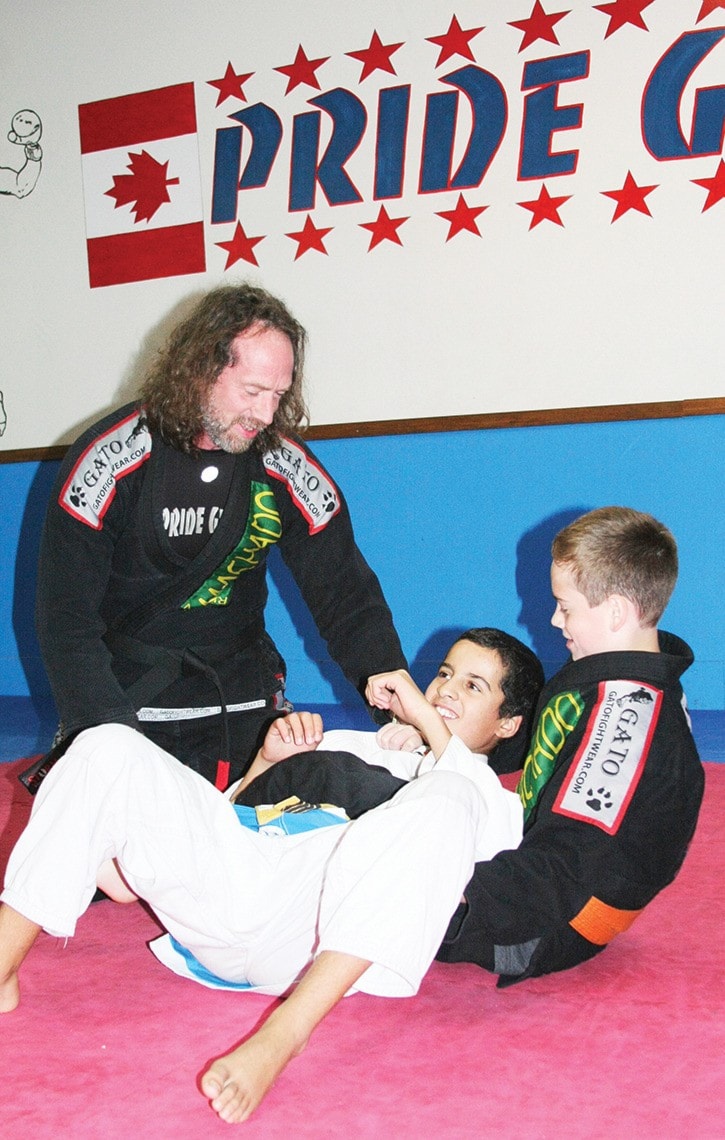Brazilian Jiu Jitsu is a perfect example of how simplicity can be the hardest thing to master, but for Pride Gym instructor Corey Colwell the study and practice of the unique Martial Art is all part of his personal growth, and an education he’d like to pass on to others.
Colwell spent the past 10 years studying the art of Brazilian Jiu Jitsu (BJJ) and recently earned his black belt under Bart Smith and the auspices of Rigan Machado, a difficult if not rare accomplishment.
“I think this makes me the second or third Machado black belt in Canada,” said Colwell. “I could only find one other guy, so it makes me the only Brazilian black belt in the Kootenays, East or West.”
Colwell made regular trips to Spokane to study and train, and Smith would come to Trail a few times each year for testing, while Machado, who lives in Los Angeles, visited annually.
Jiu-Jitsu, which means the “gentle art”, is the oldest form of martial arts. It originated in India and then spread to Japan, and it’s Brazilian incarnation began with Helio Gracie, son of a Brazilian scholar. Gracie was frail and weighed only 135 pounds, and so at age 16 he began learning Jiu-Jitsu. Because of his size he began to work with and adapt the basic rules of Jiu-Jitsu. He introduced the application of leverage to the art, making it possible for a smaller opponent to defeat a larger one through leverage and simplicity.
“It becomes a mind game,” explained Colwell. “It’s not about punching and kicking. It’s all submissions, joint locks, and positioning. Most bullying or attacks go to the ground so if you don’t know how to protect yourself on the ground, you’re going to have a bad day. ”
Colwell also holds black belts in Ninjutsu and Japanese Jiu Jitsu but his black belt in Brazilian Jiu Jitsu was decidedly his most challenging.
“This bar none has the highest standard,” he explained. “Even if you started when you were six, under the International Brazilian Jiu Jitsu Federation, you can’t get a black belt until you are 19. So pretty high standards.”
The addition of the BJJ black belt to Colwell’s repertoire is not simply a means to enhance his skills, but more as an opportunity to enhance his ability to teach.
Since its emergence from its parent art of Judo in 1914, BBJ has become not solely a martial art but also a sport, a method for promoting physical fitness and building character in young people, and, ultimately, a way of life (Do).
Sparring and live drilling play a major role in training, and a premium is placed on performance, especially in competition, in relation to progress and ascension through its challenging ranking system.
“People on the outside of Martial Arts think black belt is the pinnacle, but people in the art will tell you that black belt is like graduating high school,” suggested Colwell. “Some people would say, ‘That’s when you really start to learn.’ Especially in the higher belts it becomes more about your ability to teach other people. It’s great if you’re Wayne Gretzky the hockey player, but if you’re Wayne Gretzky the coach, I might want Scotty Bowman.”
The difficulty in attaining the belt can also be attributed to the lack of training opportunities available, and Colwell, although proud of his accomplishment, realizes BJJ’s original ideals have become somewhat compromised.
“It has become very cost prohibitive for something that started off with a wealthy family that catered to poor people in Brazil,” said Colwell. “You’re talking about an extremely big investment, financially, and time-wise, away from your family.”
Classes, competitions, and travel costs can add up, but with the addition of more local gyms in Castlegar, Nelson, and Cranbrook and trained instructors like Colwell, local practitioners will eventually be able to compete closer to home, rather than having to travel long distances for tournaments.
“Hopefully if there is more of us here, then there is more opportunity for tournaments.”
While the BBJ black belt is a tremendous accomplishment, the Ontario native realizes that it also brings higher expectations and greater responsibility; but it’s a challenge Colwell embraces and hopes to share with others.
“I have other black belts, but this one, I’m most proud of. I worked the hardest to get this, it cost me the most, I sacrificed the most,” he added. “In the end, I just want to be the best teacher that I can conceivably be.”
Colwell is available for seminars and private consultation, contact him at corey@pridegym.ca.
